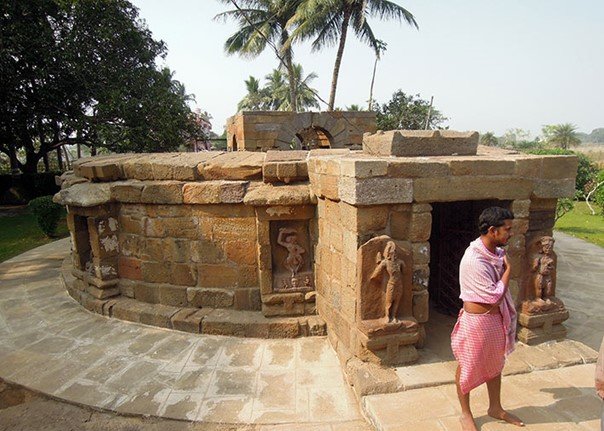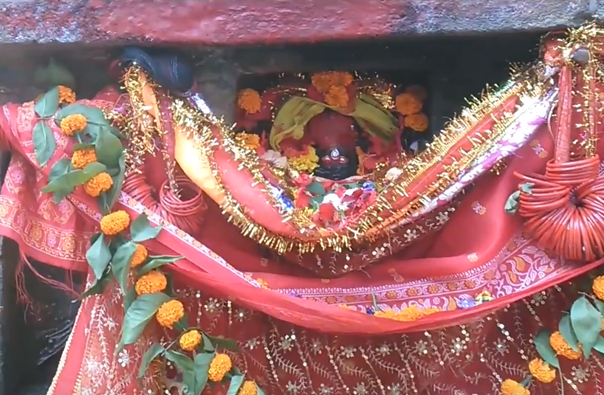Calling on the Fierce Goddess
This blog post started life as an assignment for my Master’s degree, to assess a piece of art in situ in an Indian temple. I picked the statue of Chamundi at the Sixty-Four Yogini Temple in Hirapur.
In the wake of this week’s repeal of Roe v. Wade by the US High Court, the fierce goddesses are talking to me a lot. As Carol P. Christ said, ‘Women need the Goddess’. Women need archetypes and role models beyond what the patriarchy can tell us about being a good girl, looking a certain way, behaving in a comfortable way... What can the fierce goddess Chamundi tell us?
Padma Kaimal (2005) described how to seek out and recognize the substantial presence of goddesses in Indic temple architecture. In the case of the so-called Chausathi (Sixty-Four) Yoginī temple at Hirapur, there is no need to look so hard. The divine feminine form is present in abundance. One of these yogini figures, called ‘Yoginī fifty-six’ is commonly acknowledged to be the fierce goddess, Chamundi (also known as Chamunda and Chamuneswari).
Orissa contains two temples to the sixty-four yoginis, one at Hirapur near Bhubanesvar (Fig. 1, site O), and the other some two hundred miles away at Ranipur-Jharial (site N).
Figure 1: Map of the Yogini temples in India (DuPuis, 2014)
The yoginīs of Hirapur depict predominantly beautiful-bodied women with rounded breasts, slender waist and broad hips, wearing a skirt held in place by a jewelled girdle placed low on the hips. They are ornamented with necklaces and garlands, with armlets, bangles, anklets, earrings and elaborate headdresses.
Figure 2: Yoginī statues at Hirapur Temple
Some statues present us with more challenging countenances, however: some have non-human heads, others drink from skull cups or stand on corpses. Yoginī No. 56 aka Chamundi is probably the fiercest.
Figure 3: Chamundi, Hirapur Yoginī No. 56
Chamundi’s statue at Hirapur has a damaged face, perhaps through erosion but more likely purposeful iconclasm. (Interestingly, the more classically beautiful statues show less signs of damage, perhaps as these show a more acceptable face of femininity?) Nonetheless, she still demonstrates fierce power, with a skeletal but sinewy four-armed figure, with a sunken stomach and flaccid, pendulous breasts, ribs visible between them. She wears a garland of skulls, and a headdress of flames, and holds a decapitated human head and a dagger in her lower hands, and a lion carcass above her head in her upper hands. Her vāhana (mount) is a musk deer.
To find Chamundi at Hirapur temple, the seeker must enter the temple through a constricted passageway, so low that a visitor must stoop, perhaps enforcing deference, or even to suggest the feeling of entering a womb. The sixty niches around the interior wall are approximately two feet tall, and each is treated as an individual Yogini shrine. Traditional Hindu circumambulation of a central shrine is done clockwise (Fig. 10). If approached in this manner, Chamundi is located five niches (approximately six feet) from the completion of the circle (Fig. 9). I have long pondered upon why Chamundi is almost at the end of the circumambulation around the temple. Before I examine this more, let’s first look at who and what are the yoginis and their temples.
Figure 4: Yoginī, a female adept of yoga.
While ‘Yoginī’ can be the name of a female adept of yoga, the Yoginīs of the Hirapur temple are of a different nature. The Yoginīs were also powerful, sometimes martial, female divinities with whom human ‘witches’ were often identified. Focus of a tantric cult at its height between the 9th and 12th centuries CE, their temples were generally in isolated locations and their practices transgressive; their power was intimately connected to the flow of blood, both their own menstrual and sexual emissions, and the blood of victims. They were reputedly possessed with the power of flight; they took the form of humans, animals, or birds, and often inhabited trees.
In the tantric religions, the male and female participants are conjoined physically, representing Shiva and Shakti, the male and female principles, in a similar manner to the hieros gamos, sacred marriage, of ancient Greece. For Tāntric initiates, the equivalent ritual is the the cakrapūjā, ‘wheel ritual’, and the Yoginī is the female partner in the rite. The Yoginīcakra, the wheel of Tāntric divine feminine powers, formed the textual template for both the enactment of the cakrapūjā ritual and the plan of the Yoginī temples. Examples have been discovered (Fig. 5) with segments numbered from 1 to 64, each containing the name and sometimes the drawing of a yoginī.
Returning to the statue of Chamundi at Hirapur, it seemed strange to me that such a fierce goddess was riding on a musk deer, an apparently meek animal. The musk deer, however, produces musk, the scent of kings. Musk is said to have a transformative effect on the psyche, to be an ingredient of a tonic capable of resuscitating exhausted vital energies, and to be a powerful aphrodisiac lending its wearer an enormous charge of physical attraction. All of this is interesting to consider in the context of what we know about the Yoginis and their practices.
Figure 5: 19th century Rajastani yoginīcakra on paper
The Yoginī cult can be considered part of Kaula tantra, practices that grew out of the tantric movement, but with more extreme practices, including people of marginalised professions and polluting locations: the dūtīs (female consorts) for cakrapūjā were low caste, such as washerwomen, leather-workers, and prostitutes. The Yoginīs were associated with Kāpālikas (Figure 6 below), a heterodox sect of Saivism and Kaula Tantra whose cult practices involved consumption of meat and wine from kapalas (skull bowls), human sacrifice, cannibalism, rites using human corpses and eroticism. This image also indicates the wild Yoginīs’ dedication to Śiva through the small shrine containing a śivaliṅga, and the crescent moon that shines at Śiva’s forehead hanging in the sky above. Chamundi’s statue at Hirapur shows parallels with these wild and emaciated Kāpālikas.
These fearsome Yoginīs circled together in cemeteries and cremation grounds, offering human victims to Śiva, who they worshipped as Bhairava. They performed śāva sādhanā, ritual with human corpses, to obtains siddhis (‘superhuman powers’). The late eighth century Tantrasadbhāva describes ritual centred upon Cāmuṇḍā and Caṇḍā Kāpālinī (‘Skull Bearer’) performed in temples linked with the Yoginīs, said to bring about direct encounter with the Yoginīs of grotesque visage, roaming through the sky. In summary, Chamundi and fierce female deities can be seen as gatekeepers for the fierce seasons of human life, and for the transformation that these experiences offer.
Figure 6: Grotesque Yoginīs in a cremation ground, a place of pollution.
Returning to HIrapur, Yoginī temples are generally circular, hypaethral (open to the heavens - perhaps because of - or leading to - the reputation for practioners’ ability to fly) temples of sixty-four divinities, that do not follow classic Indian temple design: there is no vimāna (tower over the central shrine). Hirapur measures 27.4 metres in circumference, with walls only 2.4 metres high, constructed of coarse sandstone.
Figure 7: Hirapur Yogini temple exterior, with person to show relatively small height of entrance and temple circumference walls
Figure 8: Classic Indian Temple design (Michell, 1997)
Classic Indian temple (Figure 8) design symbolises the cave below and mountain above, with the cosmic axis joining the shrine (*) to the heavens via the vimāna (left). Axes of energy radiate out from the sanctuary with secondary representations of the focus deity at cardinal and ordinal compass points (right). The phallic tower over the central shrine is missing from the Hirapur temple design, as can be seen from the photograph. From the plan below, it can be seen that the temple is in fact womb-shaped; as mentioned previously, the entrance is low and constricted, like a birth canal.
Figure 9: Plan of Hirapur yogini temple, showing womb-like shape, central shrine and relative position of Yogini 56, Chamundi
The diagram below shows the dynamics of traditional, orthodox Hindu temple worship: the approach to the shrine, and the ritual circumambulation (pradakshina) is carried out in a clockwise direction. Presumably this current tradition is why the yogini statues at Hirapur have been numbered clockwise in reference texts.
Figure 10: Dynamics of traditional, orthodox Hindu temple worship: the approach to the shrine, and the ritual circumambulation (pradakshina)
However, the yogini cult was not orthodox. It was transgressive and heterodox, and its secrets were closely guarded. The exterior of the temple is surrounded by nine fierce, female, armed, guardian statues called Kātyāyinī, perhaps to discourage intruders (Figure 11). The temple itself was built in a remote location, to facilitate secretive ritual. Its secrecy and remoteness are demonstrated by the fact that that the building is generally in good repair: it had been abandoned and forgotten prior to British rule, and only re-discovered in 1953.
Many modern ‘transgressive’ (e.g. witchcraft and shamanic) rituals use a counter-clockwise movement to represent an ‘unwinding’ of that which is no longer required, so perhaps Hirapur was not circumambulated clockwise, but in the opposite direction?
Figure 11: One of the nine fierce Kātyāyinī , guardian statues
One final detail of the Hirapur temple is that its primary contemporary dedication is to Mahamaya, the goddess whose name means the ‘great illusion’. The figure of Mahamaya is positioned diametrically opposite the temple entrance; to preserve her mystery, she is generally covered with cloth (Figures 12 and 13).
Figure 12: Mahamaya’s shrine at HIrapur
Figure 13: Mahamaya ‘The Great Illusion’
So here is where I veer away from the academic, and move into the realm of ‘gnosis’, received wisdom from the universe and from these deities. I have a real feeling sense that the practitioners in this temple would enter the temple, as if they were going back into the womb, with the intention of undergoing a journey of transformation, an egoic death. Many of the ancient spiritualities featured this egoic death and rebirth - the ‘womb-tomb’ - in physical constructions that supported that journey, for example, the ancient European longbarrows, and the labyrinth of many traditions. Further, an egoic death can often be triggered in life by a catastrophic event, such as the death of a loved one, or the loss of a treasured identity such as a job: occasions that can trigger a ‘dark night of the soul’. The first lesson in A Course in Miracles says ‘Nothing I see in this room means anything’, inviting us to wake up to the illusory nature of our reality, the illusion of ego, and be transformed into a life of greater, deeper meaning.
For me therefore, I see Hirapur temple as a cauldron of egoic transformation: the practitioner must navigate the fierce, armed external guardians (the guardians of the ego), transit the birth canal back into the womb-tomb, and, moving anticlockwise, in an ‘unwinding’ of egoic reality, stand before Chamundi, as gatekeeper and midwife in this transformation. We invite Chamundi’s tools, her fierce strength and her dagger, to decapitate the ego. Perhaps we even offer her something of ourselves, some menstrual blood, or something of our life that we wish to shed, and perhaps in return she cloaks us with the lion skin for strength and courage, and anoints us with the scent of the musk deer to carry us through the ritual, transforming our ego and making us irresistibly attractive to the life that we are calling in (and the partners in the ritual who participate in the transformation). Chamundi invites us to face the fierceness, go to the cremation grounds and burn ourselves down to our essence; we confront the dark night of the soul as we move into the Maya, the unknown and the illusion, and emerge via the beauty, like the wings of the butterfly growing from the caterpillar. We re-emerge through the birth canal, renewed and transformed, reborn as something new.
Right now, in the world, I feel that we are facing the guardians of ego - the patriarchal rulemakers who want to drag us back to a time where women have no agency over their own bodies - and we have to stand up and be activists. We have to embody Chamundi and be the fierce hags who can midwife this world past Maya, past the great illusion, and towards the whole world growing its butterfly wings.
Thank you for reading!
You may also be interested in reading my blog posts A Story of Accessibility: Gender and Caste in the History of Yoga and Reclaiming Persephone's Agency.
Please do contact me if you would like to work with me therapeutically.
My next Yoga Teacher Training programme starts in Jan 2024.
Bibliography
Christ, Carol P. (1978) Why Women Need The Goddess, https://womrel.sitehost.iu.edu/Rel433%20Readings/Christ_WhyWomenNeedGoddess.pdf
Das, Adyasha (2019) The Chausathi Yoginis of Hirapur: from Tantra to Tourism, Black Eagle Books.
Dehejia, Vidya (1979) Early Stone Temples of Orissa, New Delhi: National Museum.
Dehejia, Vidya (1986) Yogini Cult and Temples, New Delhi: National Museum.
DuPuis, Stella (2008) The Yogini Temples of India: In Pursuit of a Mystery, Travel Notes, Varanasi: Pilgrims Publishing.
Gadon, Elinor W. (2002) "Probing the mysteries of the Hirapur Yoginis." ReVision, vol. 25, no. 1, 33+.
Hatley, Shaman (2012) “From Mātṛ to Yoginī: Continuity and Transformation in the South Asian Cults of the Mother Goddesses.” Transformations and Transfer of Tantra in Asia and Beyond, ed. István Keul, Walter De Gruyter.
Kaimal, Padma (2005) "Learning to See the Goddess Once Again: Male and Female in Balance at the Kailāsanāth Temple in Kāñcīpuram." Journal of the American Academy of Religion 73/1, 45-87.
Kinsley, D. (1986). Hindu Goddesses: Visions of the Divine Feminine in the Hindu Religious Tradition. University of California Press.
McDaniel, June (2004) Offering Flowers, Feeding Skulls: Popular Goddess Worship in West Bengal, US: Oxford University Press.
Michell, George (1977) The Hindu Temple: An Introduction to its Meaning and Forms, London: University of Chicago.
Roy, Anamika (2015) Sixty-Four Yoginis: Cult, Icons, and Goddesses, New Delhi: Primus Books.
Saravanan, V. Hari (2014). Gods, Heroes and their Story Tellers: Intangible cultural heritage of South India, Notion Press.
Schucman, Helen (2007) A Course in Miracles, Course In Miracles Society.
Sepie, Amba J. (2016) Ecstasy and Danger: Yogini, Woman, Witch and Whore, Academia.edu. https://www.academia.edu/24467136/Ecstasy_and_Danger_Yogini_Woman_Witch_and_Whore
Spagna, Luisa (2014) La danza segreta delle Yogini. Il tempio di Hirapur, Venexia.
Wallis, Christopher D. (2002) Yoginīs: Apotheoses of Nature, Academia.edu. https://www.academia.edu/12404372/Yogin%C4%ABs_Apotheoses_of_Nature.
White, David Gordon (2003) Kiss of the Yogini: Tantric Sex in its South Asian Contexts, Chicago: University of Chicago.














